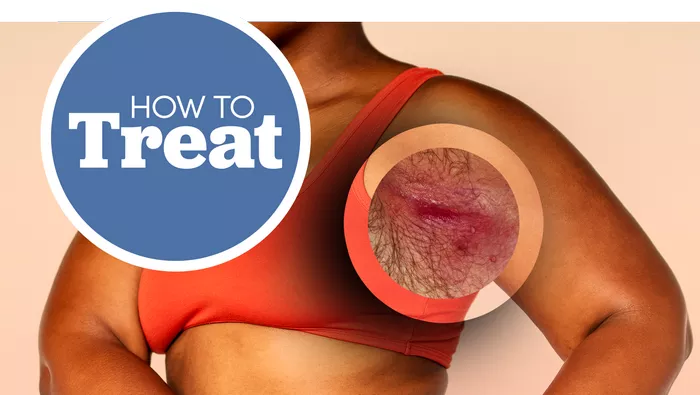Hidradenitis suppurativa (HS) is a chronic inflammatory skin condition characterized by painful nodules, abscesses, and sinus tracts, primarily affecting areas rich in apocrine glands, such as the axillae, groin, and buttocks. Beyond its physical manifestations, HS significantly impacts patients’ quality of life due to its chronicity, unpredictability, and the intensity of pain associated with flare-ups.
The Nature of Pain in Hidradenitis Suppurativa
Pain in HS is multifaceted, ranging from mild discomfort to severe, debilitating pain during flare-ups. The inflammation and formation of abscesses and sinus tracts contribute directly to the pain experienced by patients. The pain can be throbbing, stabbing, or burning, and it often worsens with movement, pressure, or friction in affected areas.
The chronic nature of HS means that patients may experience pain not only during active flare-ups but also due to the presence of scar tissue and chronic inflammation in affected areas. Managing HS-related pain requires a comprehensive approach that addresses both acute flare-ups and ongoing discomfort.
Medical Treatments for Pain Relief
1. Topical and Oral Pain Medications: Non-steroidal anti-inflammatory drugs (NSAIDs) and analgesics are commonly used to alleviate pain during HS flare-ups. Topical treatments, such as lidocaine patches or creams, can provide localized relief.
2. Systemic Treatments: For moderate to severe cases, systemic therapies like antibiotics (to control bacterial colonization), corticosteroids (for anti-inflammatory effects), or biologics (targeting specific inflammatory pathways) may be prescribed to reduce inflammation and pain.
3. Surgical Interventions: In cases of severe, recurrent HS that does not respond to other treatments, surgical options such as drainage of abscesses, excision of affected tissue, or laser therapy may be considered to alleviate pain and prevent future flare-ups.
Lifestyle Modifications and Self-Care Strategies
1. Wound Care and Hygiene: Proper wound care, including gentle cleansing with mild soap and water, and keeping affected areas dry and clean, can help prevent infection and reduce pain.
2. Pain Management Techniques: Heat or cold therapy, gentle stretching exercises, and wearing loose-fitting clothing made from breathable fabrics can provide symptomatic relief and prevent exacerbation of pain.
3. Weight Management: Maintaining a healthy weight can reduce friction and pressure on affected areas, potentially decreasing pain and discomfort associated with HS.
SEE ALSO: Can Accutane Cause Hidradenitis Suppurativa?
Psychological Support and Coping Strategies
1. Counseling and Support Groups: Managing chronic pain associated with HS can be emotionally challenging. Counseling or joining support groups can provide emotional support, coping strategies, and a sense of community.
2. Mindfulness and Stress Reduction: Practices such as mindfulness meditation, yoga, or deep breathing exercises can help reduce stress levels, which may in turn alleviate pain perception.
3. Pain Diary and Self-Management: Keeping a diary to track pain triggers, symptom severity, and response to treatments can empower patients to identify patterns and make informed decisions about managing their condition.
Integrative Approaches and Alternative Therapies
1. Nutritional Considerations: Some patients find that certain dietary changes, such as reducing intake of processed foods or dairy, can help reduce inflammation and pain severity.
2. Herbal Remedies and Supplements: While evidence is limited, some individuals report symptom relief from supplements like zinc, turmeric, or fish oil. However, it is crucial to consult with a healthcare provider before starting any new supplement regimen.
3. Acupuncture and Massage: Complementary therapies such as acupuncture or therapeutic massage may provide temporary relief from pain and improve overall well-being in some patients.
The Importance of a Multidisciplinary Approach
Managing pain in HS requires a collaborative effort between dermatologists, pain specialists, and other healthcare providers. Tailoring treatment plans to individual needs, addressing both physical symptoms and emotional well-being, and continuously evaluating the effectiveness of interventions are essential components of managing this complex condition.
Conclusion
Hidradenitis suppurativa poses significant challenges to patients, particularly due to the chronic pain associated with the condition. However, with a multidisciplinary approach combining medical treatments, lifestyle modifications, psychological support, and complementary therapies, patients can achieve better pain management and improve their overall quality of life. Ongoing research into new treatment options and a deeper understanding of HS pathophysiology offer hope for more effective pain relief strategies in the future.
By addressing pain in HS comprehensively and holistically, healthcare providers can empower patients to better manage their condition and minimize its impact on their daily lives.
Related Topics:

























